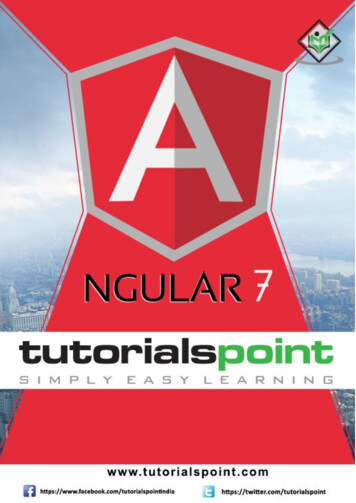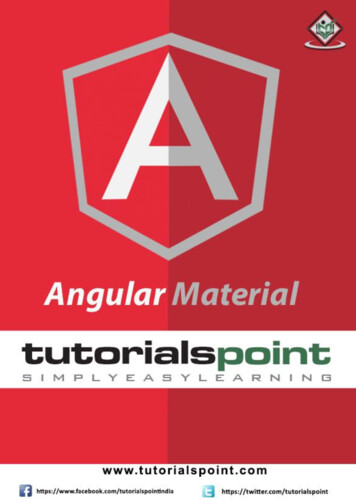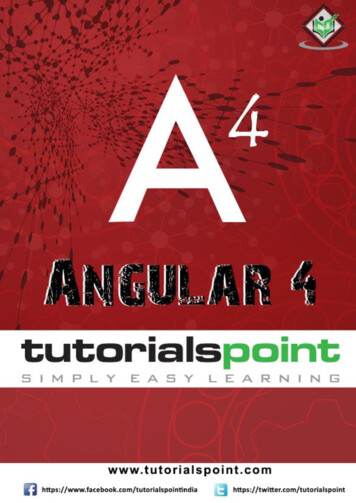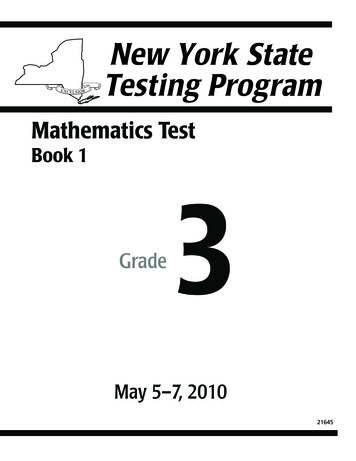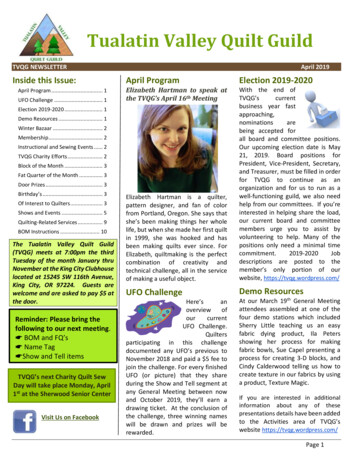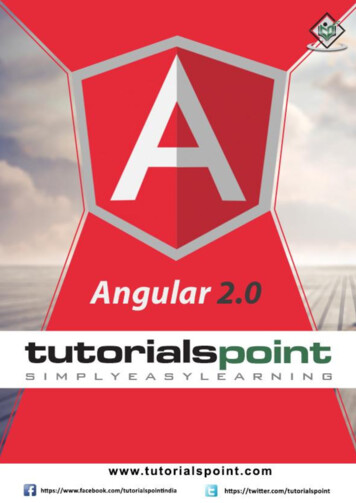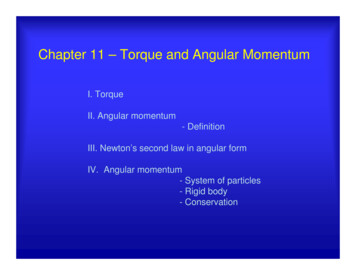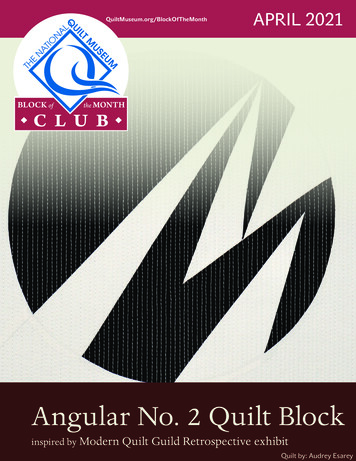
Transcription
QuiltMuseum.org/BlockOfTheMonthAPRIL 2021Angular No. 2 Quilt Blockinspired by Modern Quilt Guild Retrospective exhibitQuilt by: Audrey Esarey
APRIL 2021Featured Artist: Audrey EsareyAudrey EsareyAudrey is a modern graphic quilt artist fromLouisville, KY. Always a maker, she learnedto sew at a young age and made her firstquilt in 2005. In 2018, she set a personalgoal to exhibit her work in a juried quiltshow, which motivated her to design andcreate a series of original quilts. She sharesher creative process and her patterns online.Website: www.CottonandBourbon.comInstagram: @CottonandBourbonPage 2
APRIL 2021Inspiration"Sonder" by Terry PeartModern quilting has existed in many formsfor much of the 20th century. It wasn’tuntil the 2000’s that quilts with a modernaesthetic, the use of bold colors and prints,high contrast and graphic areas of solidcolor, improvisational piecing, minimalism,expansive negative space, and alternategrid work began to appear in greater numbers and quilters began to describe themselves as modern."Finger Paints" by Laura LoewenThis exhibition is a collection of quilts madeby members of The Modern Quilt Guildover the first ten years of the organization.Page 3
APRIL 2021Sample BlockSample by: Audrey EsareyThis block is part of my Angular Quilt Series, and it combines two of my favorite techniques: curvedpiecing and foundation paper piecing. While I suggest using solids or prints that read as solid fabrics,this block can be successful by using two colors, or by using many colors from your stash.Fabric & Thread Requirements:1 - FQ background color1 - FQ (or equivalent scraps from your stash) of contrasting color1 - 15 inch square backing fabric1 - 15 inch square of battingQuilting thread to coordinate with fabricThe sample quilt uses Kona Snow for the background and backing, Kona Black for the contrastingcolor, and Aurifil 50 wt. 2021 for piecing and quilting thread.Page 4
APRIL 2021Color SelectionI find this pattern works best with high contrast fabrics. Below, see two alternate color variations to help you envision your color choices; one option has a dark background / whiteaccents, and the other block was made with a light background / dark accents, all in the tealgreen hue family. There is a coloring sheet on page 6 to audition your color choices beforemaking the block. You may also choose to use this coloring sheet to place small scraps of yourchosen colors to assist with fabric placement while piecing the block.Page 5
APRIL 2021Coloring SheetPage 6
APRIL 2021InstructionsPhoto 11. Print the paper templates at 100% scaleand check the 1 inch test block for accuracy.2. See Template Pages for a template pageassembly reference.3. Using a light box or a window on a sunny day, carefully line up the guidelinesfor each paper template and tape themtogether using clear tape. Take care tobe very precise, as the future success ofyour pattern depends on this accuracy.Trace any pattern markings, letters, orregistration marks hidden by overlapping pages from taping together thepages.Click here to downloadthe Angular No. 2Pattern template pagesfor printing!4. Rough cut around the outer dashed lineof each template to prepare for the nextstage, cutting the fabric (Photo 1)!Friendly Reminder: Templates areprinted in reverse as a paper piecingstandard. Since the fabric is sewn to theback of the paper, the templates mustbe printed in reverse to achieve the finaldesign. Consider this for fabric placement.Page 7
APRIL 2021Cutting the FabricPhoto 2Cutting the Fabric:5. Pair Templates A, D, and E with the appropriatecolor fabric as indicated on the color placementkey (Photo 2).You might notice the seam allowance on Template D & E is larger around the outer perimeter edges (½ inch seam allowance) - this isintentional. Quilting often shrinks the block;this extra seam allowance is provided to ensurethe block measures at least 12 ½" 12 ½" afterquilting. You will trim and square up the blockafter quilting.6. Position Templates A, D, and E with the straightedge parallel with the selvage and the curvededge traveling diagonally across the fabric (thisbias positioning allows the fabric to stretch a bitwhile sewing the curved seam in a later step).Note: When cutting Templates D & E, aligntemplates with the corners of the FQ and cutthose first. Use the remainder of the FQ to cutthe 4 pre-cut rectangles for paper piecing.7. Tape the templates to the fabric (or use patternweights) to ensure the templates don’t shiftwhile cutting the fabric.8. Cut the fabric using the outer dashed line onthe templates as the cutting line.Page 8
APRIL 2021Piecing the BlockPhoto 39. Using a marking tool, transfer registration marks to the fabric pieces by making a small mark inside the seam allowance of each fabric piece. To preventvisible marking lines on the finishedquilt, avoid making a long mark thatextends past the seam allowance line onthe fabric.10. Arrange the fabric pieces on a flat surface or design wall to prepare for piecing.11. Select pre-cut fabric pieces from Template A and Template E.12. Place Template E on top of Template Aright sides together. Match and pin atthe corners and registration mark (bluelines within the seam allowance on thetemplates with curved seams).13. Sew Template A to Template E. Pressseam open. Set aside (Photo 3).14. Cut the fabric for paper piecing Templates B & C. Use the color placementkey as your guide.Page 9
APRIL 2021Piecing the BlockPhoto 415. Reduce the stitch length to 1.5 for foundation paper piecing. Using the markednumerical order, paper piece TemplatesB and C. Use the Color Placement Keyas a guide.Click here for a brief paper piecing tutorial: Paper Piecing Tutorial Link16. Sew Template B and Template C together on the marked Template EdgeBC. Press towards Template C (Photo4).17. Carefully remove the paper from Templates B & C and set the stitch length tothe normal length.Photo 518. Place Template D on top of TemplateBC right sides together. Match and pinat the corners and registration mark.19. Sew Template BC to Template D. Pressseam towards Template D (Photo 5).20. Match and pin the block edges andwhere the curved seams meet.Page 10
APRIL 2021QuiltingPhoto 621. Sew Template Edge BCD to TemplateEdge AE. Press seam towards TemplateAE (Photo 6).22. Press the overall block. Do NOT trim /square up the block at this time.23. Layer the quilt backing, batting, andpieced quilt top. Baste.24. Thread the sewing machine with threadthat coordinates with the fabric. Load abobbin with the same color thread.Tip: I like to quilt straight lines withthread that coordinates with the lightestshade of fabric in the quilt.25. Mark a vertical line down the center ofthe block using a Hera marker or painter’s tape.26. Set the stitching length to 3.0.27. Using a walking foot and the markedline as a guide, stitch the first quiltingline vertically down the center of thequilt.Page 11
APRIL 2021Quilting28. Starting from the center stitching line,quilt additional straight lines in one inchincrements on both sides of the centerline.Photo 729. Quilt halfway between the one inchincrements to create ½ inch spacing.30. Quilt halfway between the ½ inch increments to create ¼ inch spacing.31. If you desire quilting that is more dense,quilt halfway between the ¼ inch increments to create 1 8 inch spacing.32. Trim the block to 12 ½ x 12 ½ inchessquare (Photo 7).33. The block is finished! Please share yourblock on social media using hashtag#AngularQuiltBlockFinished?Fantastic!Page 12
Page 2. APRIL 2021. Audrey is a modern graphic quilt artist from . Louisville, KY. Always a maker, she learned . to sew at a young age and made her first quilt in 2005. In 2018, she set a personal goal to exhibit her work in a juried quilt show, which motivated her to design and create a series of original quilts. She shares
